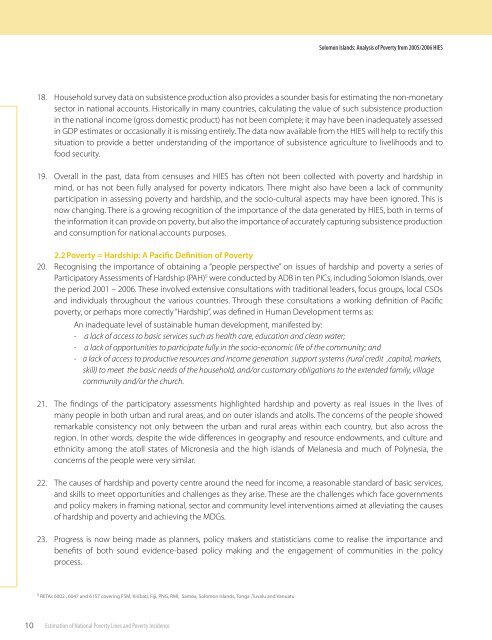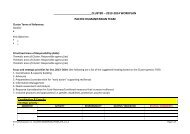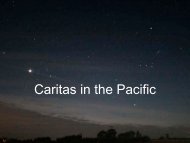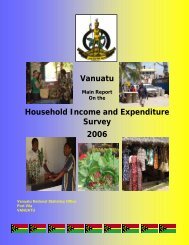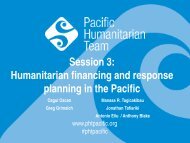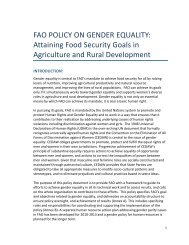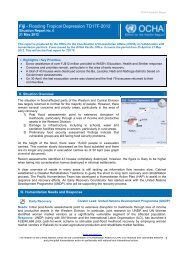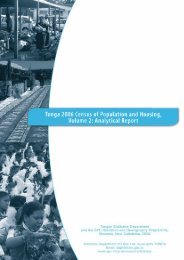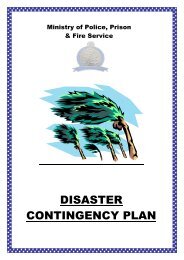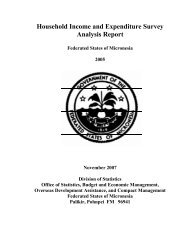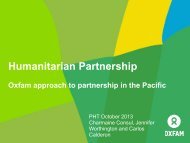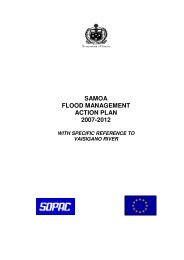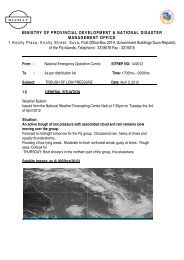<strong>Solomon</strong> <strong>Islands</strong>: Analysis of Poverty from 2005/2006 HIES18. Household survey data on subsistence production also provides a sounder basis for estimating <strong>the</strong> non-monetarysector in national accounts. Historically in many countries, calculating <strong>the</strong> value of such subsistence productionin <strong>the</strong> national income (gross domestic product) has not been complete; it may have been inadequately assessedin GDP estimates or occasionally it is missing entirely. The data now available from <strong>the</strong> HIES will help to rectify thissituation to provide a better understanding of <strong>the</strong> importance of subsistence agriculture to livelihoods and tofood security.19. Overall in <strong>the</strong> past, data from censuses and HIES has often not been collected with poverty and hardship inmind, or has not been fully analysed for poverty indicators. There might also have been a lack of communityparticipation in assessing poverty and hardship, and <strong>the</strong> socio-cultural aspects may have been ignored. This isnow changing. There is a growing recognition of <strong>the</strong> importance of <strong>the</strong> data generated by HIES, both in terms of<strong>the</strong> information it can provide on poverty, but also <strong>the</strong> importance of accurately capturing subsistence productionand consumption for national accounts purposes.2.2 Poverty = Hardship: A <strong>Pacific</strong> Definition of Poverty20. Recognising <strong>the</strong> importance of obtaining a “people perspective” on issues of hardship and poverty a series ofParticipatory Assessments of Hardship (PAH) 5 were conducted by ADB in ten PICs, including <strong>Solomon</strong> <strong>Islands</strong>, over<strong>the</strong> period 2001 – 2006. These involved extensive consultations with traditional leaders, focus groups, local CSOsand individuals throughout <strong>the</strong> various countries. Through <strong>the</strong>se consultations a working definition of <strong>Pacific</strong>poverty, or perhaps more correctly “Hardship”, was defined in Human Development terms as:An inadequate level of sustainable human development, manifested by:- a lack of access to basic services such as health care, education and clean water;- a lack of opportunities to participate fully in <strong>the</strong> socio-economic life of <strong>the</strong> community; and- a lack of access to productive resources and income generation support systems (rural credit ,capital, markets,skill) to meet <strong>the</strong> basic needs of <strong>the</strong> household, and/or customary obligations to <strong>the</strong> extended family, villagecommunity and/or <strong>the</strong> church.21. The findings of <strong>the</strong> participatory assessments highlighted hardship and poverty as real issues in <strong>the</strong> lives ofmany people in both urban and rural areas, and on outer islands and atolls. The concerns of <strong>the</strong> people showedremarkable consistency not only between <strong>the</strong> urban and rural areas within each country, but also across <strong>the</strong>region. In o<strong>the</strong>r words, despite <strong>the</strong> wide differences in geography and resource endowments, and culture andethnicity among <strong>the</strong> atoll states of Micronesia and <strong>the</strong> high islands of Melanesia and much of Polynesia, <strong>the</strong>concerns of <strong>the</strong> people were very similar.22. The causes of hardship and poverty centre around <strong>the</strong> need for income, a reasonable standard of basic services,and skills to meet opportunities and challenges as <strong>the</strong>y arise. These are <strong>the</strong> challenges which face governmentsand policy makers in framing national, sector and community level interventions aimed at alleviating <strong>the</strong> causesof hardship and poverty and achieving <strong>the</strong> MDGs.23. Progress is now being made as planners, policy makers and statisticians come to realise <strong>the</strong> importance andbenefits of both sound evidence-based policy making and <strong>the</strong> engagement of communities in <strong>the</strong> policyprocess.5 RETAs 6002 , 6047 and 6157 covering FSM, Kiribati, Fiji, PNG, RMI, Samoa, <strong>Solomon</strong> <strong>Islands</strong>, Tonga ,Tuvalu and Vanuatu10Estimation of National Poverty Lines and Poverty Incidence
<strong>Solomon</strong> <strong>Islands</strong>: Analysis of Poverty from 2005/2006 HIES2.3 What is <strong>the</strong> Poverty Line24. The estimation of poverty lines and <strong>the</strong> incidence, depth and severity of poverty in society is not an exact science.There is considerable academic as well as empirical debate about <strong>the</strong> “best” methodology. Box 1 summarises <strong>the</strong>view of <strong>the</strong> World Bank, one of <strong>the</strong> leaders in <strong>the</strong> debate on global poverty, its measurement and <strong>the</strong> developmentof policies and strategies to alleviate <strong>the</strong> hardship experienced by those who are poor.Box 1:What Makes A Good Poverty Line?We define a poverty line as <strong>the</strong> monetary cost of achieving a standard of living above which one is not deemed to be poor. A poverty comparison assesses which ofdistributions (of an agreed indicator of living standards among members of a group) has more poverty on average. The groups can be regions or sectors of a country,<strong>the</strong> same population at different dates, or <strong>the</strong> same population observed with and without a policy change. A special case of a poverty comparison is a poverty file,in which groups of households defined by some characteristic (such as where <strong>the</strong>y live) are compared at one date.The guiding principal in making a poverty comparison to inform policy is that it should be consistent with <strong>the</strong> policy objective. When that objective is to reducepoverty by increasing people’s command over basic consumption needs, any two individual (at one date or at different dates) with same command over thoseneeds should be treated identically. This requires that <strong>the</strong> poverty line should have a fixed purchasing power over relevant commodities.The cost-of-basic-needs methodThe cost-of-basic-needs method bases poverty lines on purchasing power over basic consumption needs. This achieves <strong>the</strong> desired consistency for <strong>the</strong> purposes ofBank Poverty Assessments. But putting this method into practice with imperfect data can be difficult. Once “basic needs” are defined, we need to able to measure<strong>the</strong>ir cost over time and location. Setting basic needs requires and inherent value judgement, which often leads to disagreements. Also price data are ofteninadequate.World Bank, 199425. Not withstanding <strong>the</strong> issues raised by <strong>the</strong> World Bank, <strong>the</strong> “Cost of Basic Needs” method has been used inundertaking this analysis. This method has been used on similar analyses in o<strong>the</strong>r <strong>Pacific</strong> Island countries 6 andelsewhere in <strong>the</strong> world and provides a sound and well-tested methodology.2.4 Estimating <strong>the</strong> Poverty Line for <strong>Solomon</strong> <strong>Islands</strong>26. Following <strong>the</strong> “Cost of Basic Needs” methodology <strong>the</strong> estimation of poverty lines and, from <strong>the</strong>m, <strong>the</strong> extent orIncidence of Poverty (IP) in <strong>Solomon</strong> <strong>Islands</strong> is a four step process:a) calculating <strong>the</strong> Food Poverty Line (FPL);b) estimating a non-food basic-needs component;c) combining <strong>the</strong> FPL with <strong>the</strong> non-food basic needs component gives an estimate of <strong>the</strong> Basic Needs PovertyLine (BNPL) ; and finally,d) estimating <strong>the</strong> Incidence of Poverty against <strong>the</strong> BNPL benchmark from <strong>the</strong> HIES data gives <strong>the</strong> Head CountIndex (HCI) and o<strong>the</strong>r poverty indicators measuring inequality and <strong>the</strong> depth and severity of povertybetween households.27. The Basic Needs Poverty Line is <strong>the</strong>refore made up of two components: a) <strong>the</strong> cost of food and, b) <strong>the</strong> amountof expenditure required for essential non-food basic needs. It is <strong>the</strong>refore intended to represent <strong>the</strong> minimumexpenditure per week, month or year that is required by an individual, household or family; firstly, to provide abasic, low-cost, minimally nutritious diet, (measured in terms of <strong>the</strong> minimum daily calorie intake required for basichuman survival, which is internationally benchmarked at an average of around 2100 calories/day per capita 7 ),termed <strong>the</strong> “Food Poverty Line” (FPL), and secondly, an additional amount which is required to meet <strong>the</strong> costs ofpurchasing essential non-food basic needs (e.g. housing/shelter, clothing, utilities, school fees, o<strong>the</strong>r education6 ADB Regional Poverty Programme RETA6022, 6047 and 6157 undertook similar poverty analyses in Samoa, Tonga, and FSM and jointlywith UNDP in Tuvalu and Fiji, World Bank/ADB estimates of poverty in PNG and East Timor.7 This is <strong>the</strong> FAO/WHO recommended daily minimum adult calorie intake for a moderately active adult.Estimation of National Poverty Lines and Poverty Incidence11


